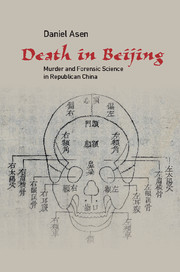Refine search
Actions for selected content:
13588 results in History of science and technology
Introduction
-
- Book:
- Death in Beijing
- Published online:
- 05 July 2016
- Print publication:
- 28 July 2016, pp 1-24
-
- Chapter
- Export citation
Bibliography
-
- Book:
- Industrial Forests and Mechanical Marvels
- Published online:
- 05 August 2016
- Print publication:
- 27 July 2016, pp 227-248
-
- Chapter
- Export citation
6 - Trolleys, Railroads, and Factories, or Civilization and Barbarism
-
- Book:
- Industrial Forests and Mechanical Marvels
- Published online:
- 05 August 2016
- Print publication:
- 27 July 2016, pp 178-213
-
- Chapter
- Export citation
Preface
-
- Book:
- Industrial Forests and Mechanical Marvels
- Published online:
- 05 August 2016
- Print publication:
- 27 July 2016, pp xvii-xviii
-
- Chapter
- Export citation
Index
-
- Book:
- Industrial Forests and Mechanical Marvels
- Published online:
- 05 August 2016
- Print publication:
- 27 July 2016, pp 249-253
-
- Chapter
- Export citation
Glossary
-
- Book:
- Industrial Forests and Mechanical Marvels
- Published online:
- 05 August 2016
- Print publication:
- 27 July 2016, pp xi-xii
-
- Chapter
- Export citation
Copyright page
-
- Book:
- Industrial Forests and Mechanical Marvels
- Published online:
- 05 August 2016
- Print publication:
- 27 July 2016, pp iv-iv
-
- Chapter
- Export citation
1 - Nineteenth-Century Modernization in Brazil
-
- Book:
- Industrial Forests and Mechanical Marvels
- Published online:
- 05 August 2016
- Print publication:
- 27 July 2016, pp 1-36
-
- Chapter
- Export citation
5 - Road-Building and Railroads
-
- Book:
- Industrial Forests and Mechanical Marvels
- Published online:
- 05 August 2016
- Print publication:
- 27 July 2016, pp 141-177
-
- Chapter
- Export citation
4 - The Most Useful of Instruments
-
- Book:
- Industrial Forests and Mechanical Marvels
- Published online:
- 05 August 2016
- Print publication:
- 27 July 2016, pp 113-140
-
- Chapter
- Export citation
3 - Industrial Forests
-
- Book:
- Industrial Forests and Mechanical Marvels
- Published online:
- 05 August 2016
- Print publication:
- 27 July 2016, pp 76-112
-
- Chapter
- Export citation
Notes on Orthography
-
- Book:
- Industrial Forests and Mechanical Marvels
- Published online:
- 05 August 2016
- Print publication:
- 27 July 2016, pp ix-x
-
- Chapter
- Export citation
Figures and Map
-
- Book:
- Industrial Forests and Mechanical Marvels
- Published online:
- 05 August 2016
- Print publication:
- 27 July 2016, pp vii-viii
-
- Chapter
- Export citation
2 - The Vocabulary of Brazilian Modernization
-
- Book:
- Industrial Forests and Mechanical Marvels
- Published online:
- 05 August 2016
- Print publication:
- 27 July 2016, pp 37-75
-
- Chapter
- Export citation
Acknowledgements
-
- Book:
- Industrial Forests and Mechanical Marvels
- Published online:
- 05 August 2016
- Print publication:
- 27 July 2016, pp xiii-xvi
-
- Chapter
- Export citation
Conclusion
-
- Book:
- Industrial Forests and Mechanical Marvels
- Published online:
- 05 August 2016
- Print publication:
- 27 July 2016, pp 214-226
-
- Chapter
- Export citation
Contents
-
- Book:
- Industrial Forests and Mechanical Marvels
- Published online:
- 05 August 2016
- Print publication:
- 27 July 2016, pp v-vi
-
- Chapter
- Export citation

Death in Beijing
- Murder and Forensic Science in Republican China
-
- Published online:
- 05 July 2016
- Print publication:
- 28 July 2016
Travancore's magnetic crusade: geomagnetism and the geography of scientific production in a princely state
-
- Journal:
- The British Journal for the History of Science / Volume 49 / Issue 3 / September 2016
- Published online by Cambridge University Press:
- 21 June 2016, pp. 325-352
- Print publication:
- September 2016
-
- Article
- Export citation

Dactylography and The Origin of Finger-Printing
-
- Published online:
- 05 June 2016
- Print publication:
- 03 December 2015
- First published in:
- 1912
